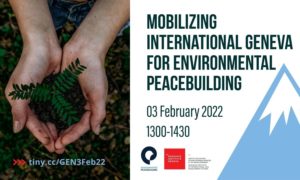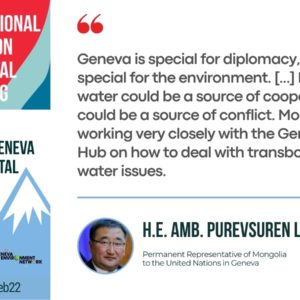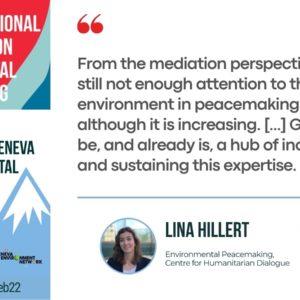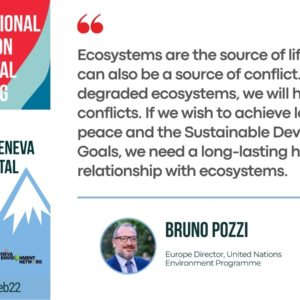Événement Virtuel
Mobilizing International Geneva for Environmental Peacebuilding | 2nd International Conference on Environmental Peacebuilding
Geneva, referred to as the capital of multilateralism, is one of the most active centers of global governance and an operational hub for multilateral diplomacy, including on environmental matters. Gathering a large pool of expertise on both environment- and conflict-related issues, organizations in Geneva can play an important role in promoting environmental peacebuilding and exploring the interlinkages with other workstreams. This session of the 2nd International Conference on Environmental Peacebuilding, convened by the Geneva Environment Network, discussed how synergies within the International Geneva community can be reinforced and developed to support environmental peacebuilding.
About the 2nd International Conference on Environmental Peacebuilding
The Second International Conference on Environmental Peacebuilding is taking place virtually from 1 to 4 February 2022. The Environmental Peacebuilding Association (EnPAx) is convening the conference in partnership with the Centre on Conflict, Development and Peacebuilding (CCDP) of the Graduate Institute of International and Development Studies, the Geneva Peacebuilding Platform, the Geneva Water Hub, the University of Geneva and the United Nations Environment Programme.
The Conference features five themes that draw attention to key environmental peacebuilding issues and their important interlinkages in the particular context of peace and conflict: Building the Evidence Base, Public Health, Business and Market, Rights and Justice, and Climate Change. It includes 5 training sessions, and 65+ panels and roundtables, with 100+ experts from 50+ countries. In addition to traditional panels and a poster session, the conference is highlighting a diversity of tools and approaches, with a photographic exhibition, networking lunches (for women and for mentors/mentees), a resume review workshop, and other dynamic sessions.
About this Session
The Geneva Environment Network and partners are hosting an event to showcase the contribution of International Geneva as a global hub of environmental governance to the field of peacebuilding. Gathering a large pool of expertise on both environment- and conflict-related issues, organizations in Geneva can indeed play an important role in promoting environmental peacebuilding and exploring the interlinkages with other workstreams. Invited experts will discuss how synergies within the International Geneva community can be reinforced and developed to support environmental peacebuilding.
This event is also organized in the run-up to the Stockholm + 50 Conference, five decades after the United Nations Conference on the Human Environment had declared that to defend and improve the human environment for present and future generations has become an imperative goal for mankind, a goal to be pursued together with, and in harmony with, the established and fundamental goals of peace and of worldwide economic and social development.
Speakers
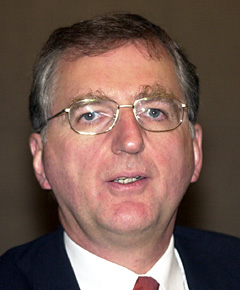
Philippe ROCH | Chair
Former Swiss State Secretary for the Environment, Member of the Geneva Centre for Security Policy Board
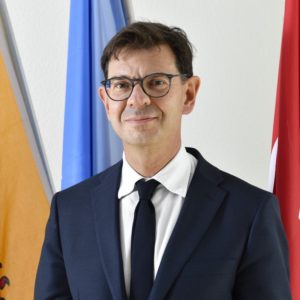
H.E. Amb. Felix BAUMANN
Deputy Permanent Representative of Switzerland to the UN Office and other international organizations in Geneva, and Permanent Representative of Switzerland to the Conference on Disarmament

H.E. Amb. Purevsuren LUNDEG
Permanent Representative of Mongolia to the United Nations in Geneva
Highlights
Click on the images below to see quotes from the speakers.
Video
Summary
Welcome and Introduction
Opening Remarks | Philippe ROCH
Switzerland inaugurated the Environmental House, where this session is convened, already twenty-three years ago. Since then, it has rapidly evolved thanks to all the actors, especially the Geneva Environment Network, which works to animate this place. By favouring cooperation and coordination among multilateral private, public, and international environmental organizations, this house has become the natural place where this session of the conference on peacebuilding and the environment is hosted. This topic is dear to all those committed to the environment as it shows the environmental engagement of different issue domains. A key milestone for this approach was the Rio Conference in 1992, where the hope of having the economy, social development and the environment really converging in a successful sustainable development was born. Despite it did not go as well as intended, the issue is still actual and requires action from various fronts.
If the environment may be a cause of conflicts, a cause of scarce resources people compete for, in history it has been much more source cooperation. The most notable example of this kind of cooperation is water: managing this resource required the work of plural people and has brought to the establishment of the first great civilisations. This historical fact is what should give up hope that forests, water, and all natural resources can be a factor of cooperation among countries, rather than being elements to wage war for. Therefore, today’s conference aims to showcase how this is not only possible but necessary.
Geneva can play an important role in establishing these kinds of collaborations thanks to its privileged host position to many environmental organizations. Caring for the environment is a good cooperation spirit among countries should be not only Geneva’s priority for the close future but of the whole global community.
For these reasons, the recent publication of a White Paper on Environmental Peacebuilding, resulting from the united work of fifty and more experts, succeeds in making these topics accessible to everyone and provides a good vehicle to circulate information and inspire action towards this goal.
Geneva Dialogue on Environment, Climate, Conflict, and Peace | Annika ERICKSON-PEARSON
To best introduce the panel discussion, the context where all this takes place requires a short explanation. To do so, it is important to cover three main issues: environmental peacebuilding; international Geneva; and where these two go together. Environmental peacebuilding, quoting the above-mentioned white paper, is “[…]an overarching framework, environmental peacebuilding includes both the environment and the dimension of peacebuilding and the peace dimension of sustainable development.” Indeed, the fact of being an overarching framework is often flagged by many as an issue, considering the broadness of the topic a challenge to its definition and operationalization, especially in terms of policymaking. Another challenge is that what we intend with environmental peacebuilding might fall into what some consider environmental security, this latter being amply ingrained within the UN system. This definition dilemma comes at a main difference between these two conceptualisations. Environmental peacebuilding is used to emphasize opportunities rather than security responses. This nevertheless does not exclude all the array of approaches undertaken by actors working in environmental security (e.g. development banks), for example addressing the extinction of species or transboundary water management can be a tool for peace.
The second point regards international Geneva. Starting from what international Geneva is not, it is not the community of people around the world that are challenged by environmental degradation, natural resources scarcity and abundance, and the aggravating effects of climate change. Geneva is also not New York, where the Security Climate Mechanism; the UN Security Council; the UN Peacebuilding Architecture and Fund are hosted. This is important to keep in mind since Geneva needs not to replicate those efforts, but rather exercise its own footprint. Conversely, Geneva is the ville de la paix for all the world, the home of the Human Rights Council and plural humanitarian and thematic organizations. These organizations and the experts keeping them active are deeply connected to the aforementioned communities around the world. Indeed, being home to the United Nations and their countries missions, Geneva can connect to decision-makers and help them address policy challenges for addressing these issues.
In Geneva we do not necessarily need to create something new for environmental peacebuilding but rather to channel what we already have.
The third point regards the link between environmental peacebuilding and International Geneva. For instance, the Geneva Peacebuilding Platform (GPP) engages in this topic fostering inter-organization collaboration and dialogue, to promote shared learning, innovation and to facilitate mainstreaming of these issues into organizations. The goal is to bring peace and conflict sensitivity to the environment, climate and conservation world and the other way around. This is a simple example of how through events, meetings, and publications Geneva is active on this issue.
Within the UN System, the UN Environment Programme (UNEP), the International Union for Conservation of Nature (IUCN), the UN High Commissioner for Refugees (UNHCR), International Organization for Migration (IOM) address these links, creating essential synergies with their specific field of work. To name a few of those that have included in their work the environment-peace-conflict nexus, we can think of: the Geneva Water Hub, Peace Nexus, Interpeace, Geneva Center for Security Sector Governance, Geneva Center for Security Policy, The Quaker United Nations Office (QUNO), the Conflict Center on Development and Peacebuilding (CCDP). Besides this much wider organizations ecosystems, Geneva also interacts with states participating actively on this issue. Indeed, among the near-future plans of the GPP, there is creating a map of Environmental Peacebuilding in Geneva. We are at a point where the need of talking among different actors is self-evident, but the “how” of this collaboration needs to be strengthened especially in the relationship with policymakers and mission. Only by discussing challenges can be identified and then addressed through support and evidence-based knowledge.
Philippe ROCH: There is a sort of pride around Geneva in being able to provide this platform for international cooperation. But Geneva is not alone, it simply is part of a world that has the goodwill to make this possible. To add to what was just said, it is important to say a few words about Nairobi. This city is crucial for the environment, indeed, fifty years ago in Stockholm, it was decided to place UNEP in Africa for Northern countries to never forget developing countries and their importance in fostering a sustainable relationship with the environment.
Panel Discussion
Swiss Perspectives on the Role of Geneva | H.E. Amb. Félix BAUMANN
Environment, conflict and peace are pressing issues set to gain an even major momentum here in Geneva. The links between these concepts are certainly not new, yet the international community still is to nail the framing to prevent conflict, foster sustainable peace and development.
To show a different angle international Geneva, the key areas the city is engaged in are quite telling: the humanitarian sector, migration and environment and sustainable development, labour trade, science and telecommunication. Where is the potential of international Geneva to bring together these different strengths when it comes to environmental peacebuilding? There are five main angles.
- The first and key one should be the strengthening of the network between the scientific community and political actors and the operational actors located, private sector and civil society in Geneva and beyond.
- Secondly, to harness the knowledge and expertise of all the organizations, it is necessary to strengthen one of Geneva’s historic areas of expertise: the normative framework and its operationalization.
- Third, another traditional element of Geneva is the creation of dialogue opportunities in protected spaces, favourable to the finding of agreements and solutions and conflict prevention.
- A fourth point is the interdisciplinary approach and actors engagement, key aim to look at for address a cross-sectorial challenge.
- Lastly, Geneva is known for and proudly seeks to host and favour multi-stakeholder platforms, collaborations and dialogues.
To name more concrete examples, the process that led to the creation of the White Paper mentioned before shows how Geneva actively addresses issues.
Switzerland as a country also offers a good example of engagement in the topic. Reconnecting to water, Switzerland and other fifteen countries launched the Blue Peace Initiative to support areas experiencing water scarcity and afflicted by climate change effects. Tangible results to this account for a reduction of tensions and stabilization of the relationship between different states in the Sahel region and stakeholders. International organizations, the Geneva Water Hub, in this case, help build these bridges and support the prevention and resolution of water-related conflicts and promotes water as an instrument for peace. An additional point of strength of these types of organizations is being neutral, offering parties a safe space for dialogue.
Another example is Switzerland’s program for the prevention of violent extremism, partnering with the Initiative of Change. Again, Switzerland’s cooperation with Norway to protect disaster-afflicted and displaced people led to the establishment of the Nansen Initiative, the Global Protection Agenda and the Platform of Disaster Displacement. It is also worth mentioning that besides the historic work of the International Committee of the Red Cross (ICRC) in protecting the environment in warfare, ICRC has recently published the Guidelines for the Protection of the Natural Environment in Armed Conflicts.
The program of the 2nd International Conference on Environmental Peacebuilding shows that a whole compendium rigorous analysis and practical experience, knowledge and methods in this field is in place. This is undoubtedly due to the high academic and scientific production elaborated in this sense. As a representative of the Government, a key question to be answered is how do we make the best of this scientific knowledge in our policy work to be implemented on the ground? How to move forward in the climate and environmental peace agenda? This stresses once again the importance and timeliness of this conference as a government we need dialogue and confrontation and experiences to then proceed to the implementation of these policies.
Addressing Climate Change and Security in Mongolia | H.E. Amb. Purevsuren LUNDEG
Mongolia, as a climate-change afflicted country warmly welcomes all the initiatives fostering environmental reflection and action. Geneva is a special place for both diplomacy and the environment, and their interconnection is actual today more than ever as climate change comes first in the diplomatic effort of every country. Being the kitchen of diplomacy, Geneva has played a major role in consolidating environmental action on the various fronts mentioned by H.E. Amb. Baumann.
For Mongolia, security entails facing the fact of being “sandwiched” between the two major powers of China and Russia and being landlocked. As globalisation changes this reality, Mongolia is now majorly changed by the changing climate. In the last seventy years, Mongolia has seen a 2.5°C temperature increase. More specifically, air pollution is the major issue affecting urban areas and it is set to rapidly worsen. The case of Mongolia is certainly similar to the faith many other countries are currently experiencing. The overcrowding of the capital Ulaanbaatar is caused by migration influenced coming from deserted areas, as the depletion of natural resources forces people to move. Being Mongolia still dependent on coal for heating systems and cooking, Ulaanbaatar is among the most polluted cities in the world.
Considering these, being offered the possibility to interact with Geneva florid organizations’ environment allowed for instance participating in the First World Air pollution Summit hosted by the World Health Organization. The city of Geneva also offers Mongolia plenty of occasions to access important resources and receive high-quality support, as the experience of collaboration with the Geneva Water Hub shows. The Swiss experience in water management among neighbours is vital to help Mongolia face the glaciers melting issue by monitoring and forecasting the impact of their depletion on the country’s water supplies. Additionally, the Geneva Water Hub is supporting Mongolia to respond to a climatic and geopolitical issue: hydropower. This desire is dictated by the necessity to secure energy sources but it is challenged by its closeness to the Balkan sea, encountering Russian resistance. This example shows the importance of Switzerland’s expertise and safe-space positioning in supporting countries all over the world in transboundary water conflicts. Furthermore, other Mongolian environmental challenges related to the conservation of essential pastures are provided aid by the Geneva hub.
Philippe ROCH: This intervention showcases what Annika Erickson-Pearson mentioned earlier as Geneva’s support to the distant communities afflicted by climate change. In the climate privileged situation Geneva currently is, it is an honour to be able to help countries facing their challenges. In addition, this example also stresses the importance of environmental protection for the preservation of civilisations and their cultural habits.
Environmental Peacemaking: Operationalizing the Agenda | Lina HILLERT
The work of the Centre for Humanitarian Dialogue (HD) provides a good example of how a Geneva-based organization operationalizes the nexus between environment-climate-conflict and peace. As a private peace mediation organization, HD gains its strength from its dislocated structure, which allows mediators to have direct contact with the field and follow closely the development of conflictual relationships and their resolutions.
It is important to clarify the difference between environmental peacebuilding we discussed so far and environmental peacemaking, which is what HD does an organization working for the ending of conflicts. Thus, for us, environmental peacemaking encompasses all practices that include, use or frame the environment either as an entry point to or an element of peace mediation and dialogue processes and that has had a positive effect on both the environment and peace. In a nutshell, positive peace and environmental outcomes.
We have observed in the past year an increase in the violence related to the environment and in the number of conflicts that have an impact on the environment, and so far the mediation field does not pay enough attention to the environmental field during peace processes. But this aspect is slowly changing both within HD and in the world of mediation organizations. HD’s mediation and policy support unit, based in Geneva, started working about five years ago on environmental peacemaking, seeing a quick increase in the past couple of years. Externally, organizations are seeking to adapt their tools and practices to make peace processes more environmentally-sensitive. In both cases, the work has already shown to generate specific positive impacts.
HD operations take place at local, national, regional and interstate levels, and we are witnessing the importance of the environment growing at all of these levels. Therefore, our work currently entails finding the most appropriate way to address each and connect them to make peace processes more environmentally-sensitive. An example of our operations at the local level is represented by the conflict resolution efforts in the Sahel region to prevent agro-pastoralist conflicts, currently aggravated by climate change. Actions taken to serve this purpose included the creation of a network of mediators working across five countries in the Sahel to address micro-level disputes related to natural resources. Again, the Nigeria team is currently developing local resource-sharing agreements. In the addressed micro-level disputes (HD annually solves around 260) and the formal/informal peace agreements (e.g. the Kafanchan Peace Declaration, the Southern Plateau Declaration), communities commit to land, pasture and water-sharing; in addition to discussing crop-destruction; grazing reserves and livestock routes.
At the regional level, environmental problems have been used as an entry point for dialogue to promote cooperation among conflict parties, evidencing the possibility of using the environment as a confidence-building tool. More in detail, the Eastern Europe group composed of experts, scientists and mediators, has facilitated informal dialogue on environmental and public health risks in armed conflict. This resulted in the inclusion of environmental clauses in official cease-fire monitoring. Again, the HD has facilitated a dialogue between policymakers and experts in the South China Sea to support coastguard interactions and sustainable fisheries management. Consequently, parties agreed to a framework regulating these interactions and to specific actions to manage marine resources. Despite these positive outcomes, all mediation organizations, including HD, must address important issues such as defining what an environmental outcome is; or how to prove the effectiveness of environmental peacemaking programs both from environmental and peace perspectives.
To reconnect to the role of Geneva, for a decentralized organization like HD having a base here is essential to stay up to date with the most recent developments, research and policy decisions. On the other hand, being in Geneva also offers the opportunity to report field-based experiences and lessons to the wider community and to generate wider positive effects. On top of this, Geneva is the perfect hub for the development of the environmental peacemaking practice, creating complementary partnerships and exchanges with climate and environmental experts is fundamental to improving mediators’ conflict analysis skills.
Philippe ROCH: It is fascinating how having a decentralized structure allows addressing such micro-level conflicts, but it would be interesting also to know whether the HD Centre also has other contacts and sources of information to make this possible.
Lina HILLERT: Besides the contact with the local and national governments and institutions established by mediators on the field, we interact with a variety of actors, including the UN, but the collaboration with environmental organizations and agencies could be developed further. This would doubly benefit our work through the inflow of environmental know-how and with the elevation of our approaches and outcomes to wider peacebuilding efforts.
The triple and interrelated crisis | Bruno POZZI
In face of the triple and interrelated crisis dictated by the loss of biodiversity, climate change, and pollution, the need for harmonized action and increased cooperation between all actors is evident. Solving this crisis is complex and this challenge will define the next half of a century and beyond. Today it was brilliantly explored how ecosystems can both be the source of life and of conflicts, showing the link between preserving the environment to avoid the increase of conflicts.
The fil rouge connecting healthy ecosystems, the achievement of the Sustainable Development Goals and sustainable peace is what moves UNEP to push actors to invest in ecosystems. Being so fundamental to our existence, it is of primary importance to address them, pending our survival. We need to reinvent a positive relationship to the environment as the environment is not “one of the boxes of development”, it is THE box of development. Any eco-social, any peace or security- engagement derives from what we do with the environment.
The role of Geneva and all its international organizations’ ecosystem is to learn the challenges and incorporate them into the policies, and consequently to put them at the heart of their analysis. Key events such as the UN Environmental Assembly and the celebration of the Stockholm+50, offer a great opportunity to bring peacebuilding around the environmental dimension of development. This socio-economic issue naturally calls Geneva, the hearth of the SDGs, to be at the forefront of the greening of peacebuilding policies. And thanks to conversations like this and events like the 2nd Conference on Environmental Peacebuilding, it is clear that this awareness is swiftly spreading.
Philippe ROCH: Everything that wants to be done for making a better world pivots around the capacity to maintain or preserve ecosystems.
Discussion
Q: Behind many current environmental negotiations a geopolitical challenge and conflicts exist. Would you see experiences in the field of disarmament that could be relevant or of inspiration to work on environmental issues?
Q: What do you think of the newly created Geneva Science and Diplomacy Accelerator (GESDA)? Do you think it can participate in environmental peacebuilding, seeing the interdisciplinary and multi-stakeholder approach required?
H.E. Amb. Félix BAUMANN: Concerning the first question, it is challenging to compare the two processes as mechanisms and dynamics vary greatly. But conflict and geopolitical dynamics remain the same, thus there are some areas where some linkages can be more easily done. For instance, urban warfare, arms trade are fields where possible damages to the environment have some similarities. A field where some synergies can be found is humanitarian disarmament, where we implement a functioning mechanism of donor and actor involvement that could be replicated for environmental peacebuilding. The GESDA aims at mapping what kind of international governance is needed to make sure the frontier technologies of the coming years (e.g., neuroscience, quantum computing) are framed to ensure the maximum benefits for humanity while reducing the risk. Climate change is among GESDA’s priorities, not in terms of peacebuilding, but still represents a possibility to exploit by various organizations.
Q: Do you see a role for private diplomacy to advance urgent climate action, connecting it to peace and the environment?
H.E. Amb. Purevsuren LUNDEG: The role of diplomacy is crucial in environmental talks. Considering the interrelation and complexity of global issues, diplomacy is taking a multi-perspective approach in all its actions, and it is putting the environment in its top priorities. Another process we are experiencing is the nearing between different worlds, the diplomatic one needs to learn the language of the environment and the other way around to approach this interrelated world.
Closing Remarks
Annika ERICKSON-PEARSON: To reconnect to the questions asked about recommendations to young professionals, the concept of intergenerational exchange is essential to various fields and especially to climate change action. Practically speaking, there are major networks as the UN Forum on Children and Youth, IUCN related ones as the Global Youth Biodiversity Group and many more. But this also gives the chance to encourage the people who are not young professionals to create opportunities for young people, actively fostering intergenerational panels, workspaces, and initiatives.
H.E. Amb. Purevsuren LUNDEG: The intergenerational example is useful also to touch upon learning from past mistakes, applicable also to developing countries who should avoid errors done by others. Geneva represents itself this sort of repository, where expertise is shared and circulated to prevent mistakes and improve conditions.
Lina HILLERT: International Geneva has a key role in mobilizing for environmental peacebuilding, but in the end environmental solutions come from bottom-up action on the group. Therefore, in Geneva, we have to ensure policymakers implement what works on the ground to strengthen cooperation.
Bruno POZZI: Intergenerational responsibility is crucial as much as the need FOR a holistic effort from all actors. Reconnecting to the geopolitical discourse, the habit of separating security and peace prevents from seeing them as embedded in ecosystems and the environment. The transboundary nature of the environment makes it naturally geopolitical and thus we should look at geopolitics from an environmental angle because the key to peace is often found in human beings’ relations with the ecosystems.
Philippe ROCH: It is common to be pessimistic about the future, but a conversation like this replenish hopes that these efforts will make the future possible.
H.E. Amb. Félix BAUMANN from Switzerland had to leave earlier and could not deliver a closing statement.
Links
- A White Paper on the Future of Environmental Peacebuilding: Nurturing an ecosystem for peace
- The Road to Geneva | Environmental Peacebuilding
- 2nd International Conference on Environmental Peacebuilding
- ‘Environmental peacebuilding is essential and complex – but it’s also exciting’ | Carl Bruch | Geneva Solutions | 4 February 2022
- Why International Geneva’s ‘human dimension’ bodes well for environmental peacebuilding| Annika Erickson-Pearson | 2 February 2022
- International Geneva turns focus to nature and peace | Geneva Solutions | 31 January 2022

